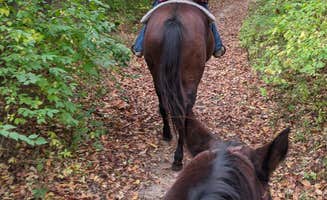Equestrian trails in southwestern Ohio offer varied terrain for riders of all skill levels. Most parks near Belmont maintain trail systems ranging from easy meadow paths to more challenging wooded routes with elevation changes and stream crossings. Trail networks typically interconnect, allowing for rides lasting from 30 minutes to several hours depending on the loop chosen.
What to do
Horseback trail exploration: At Dayton Metro Parks (Five Rivers Metroparks), riders can access the Twin Valley Backpacking Trail system. "This was a lovely backpacking trail that is both challenging while not being too hard for new backpackers," notes one visitor who appreciated the well-marked paths. The trail system includes "ravines" and covers "around 2,000 acres" with "more than 25 miles" of connected paths.
Lake activities for riders: Buck Creek State Park Campground provides options for horseback riders who also enjoy water recreation. "There are two swimming beaches, the public one and one in the campground," shares a camper, adding that after riding, "the campground one is smaller a short hike to get to it." Riders often cool down at the beach after trail rides during summer months.
Wildlife observation: Many equestrian trails run through natural habitats where wildlife spotting is common. The paths feature "wooded areas and open fields" where riders frequently encounter deer and various bird species. Early morning and dusk rides offer the best wildlife viewing opportunities, with riders advised to maintain a respectful distance and avoid approaching animals.
What campers like
Pull-through site accessibility: East Fork State Park Campground receives praise for its layout that accommodates equestrian rigs. "Camp sites are all blacktop, level, and clean," reports one visitor. The design includes wider access roads making it easier to maneuver large trailers, particularly important for equestrian campers with longer combined vehicle lengths.
Separate equestrian camping areas: Whitewater Memorial State Park Campground offers specialized camping for horse owners. One rider notes, "I came here and stayed in my tent (family had their horse trailer with camper) for a night during the chilly nights of October. I wish all campsites were like these - very, very spread out!" This separation helps minimize conflicts between different user groups and provides necessary space for equestrian equipment.
Natural surroundings: Equestrian campers appreciate the mix of environments available for riding. Trail systems often feature "varied terrain including wooded paths, creek crossings, and open meadows," providing diverse riding experiences. The trails typically loop back to camp areas, allowing riders to adjust their riding time based on weather conditions or horse energy levels.
What you should know
Seasonal considerations: Many equestrian trails near Belmont face seasonal closures or restrictions. During spring thaw periods, trails may be temporarily closed to prevent damage. Winter riding often requires special preparation including appropriate footwear for horses.
Water access planning: Hueston Woods State Park Campground provides water sources, but access points may require planning. "The campground's separate non electric loop would also be sold out," notes one visitor, adding that equestrian areas have different amenities than standard camping areas. Horse watering stations are typically available at designated points, not throughout the trail system.
Containment requirements: Most parks require horses to be contained at campsites when not being ridden. "Most equestrian campers bring portable corrals or use highlines, as permanent stalls are limited," though specific rules vary by location. Some parks allow portable electric fencing within designated site boundaries while others restrict containment methods.
Tips for camping with families
Combined activities: Cowan Lake State Park Campground offers opportunities for mixed recreation. "Lots to do for families. Nice size lots," reports one visitor. When some family members ride, others can enjoy "the nature center and several hiking or paved biking/walking trails," allowing split activities based on interest.
Child-friendly trail options: Several parks offer designated beginner-friendly loops suitable for younger or less experienced riders. These paths typically avoid steep terrain and water crossings, making them appropriate for children learning riding skills. Parks often mark trail difficulty levels similar to ski runs - green for beginner, blue for intermediate.
Educational programming: Seasonal ranger-led programs often include horse-related educational components. Programs might cover topics like local wildlife identification from horseback or historical perspectives on regional equestrian traditions. These sessions typically run 30-60 minutes and are offered on weekend mornings during peak seasons.
Tips from RVers
Specialized hookup considerations: Winton Woods Campground offers amenities that support larger equestrian rigs. "Winton Woods campground has spacious paved RV spaces with full hook-ups, fire ring, and picnic table," mentions a camper. The 50-amp electrical service proves essential when running air conditioning in living quarters during summer months.
Arrival timing strategies: Equestrian campers with larger rigs should plan arrivals during weekday daylight hours. This allows easier site navigation and setup, particularly important when backing into spaces with horse trailers. Holiday weekends and events require especially early booking, as "limited number of suitable sites fill quickly."
Dump station access: Most equestrian campgrounds feature dump stations positioned to accommodate rigs with trailers still attached. However, some may require unhitching to navigate the dump station effectively. First-time visitors should inquire about dump station configuration when making reservations to avoid surprises at departure.


